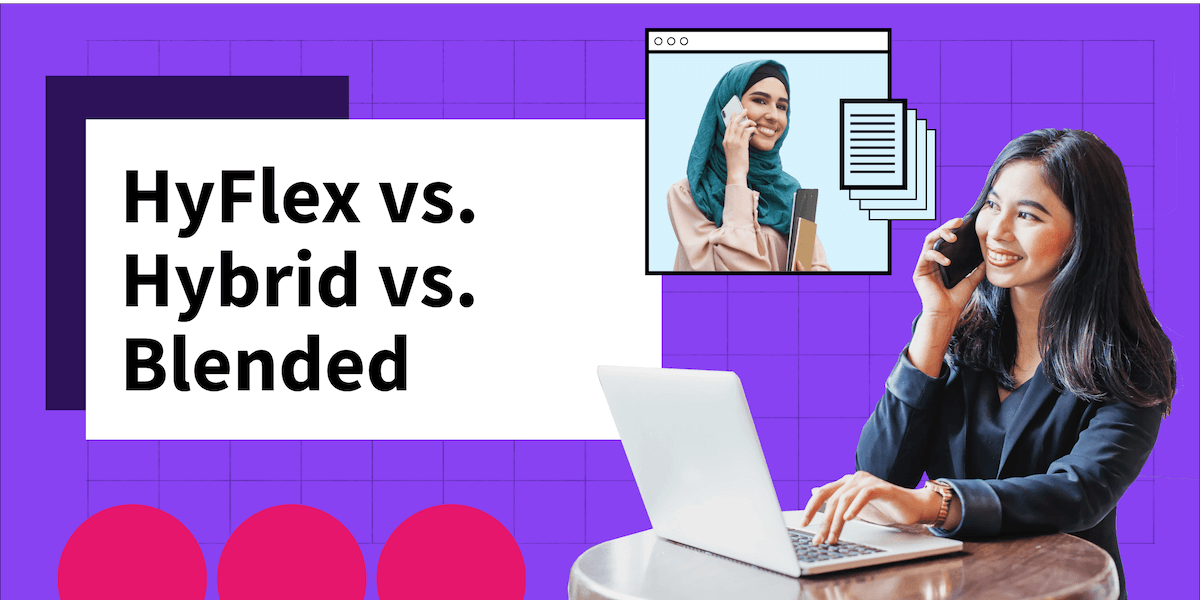For most of us, last year’s rapid pivot to remote teaching meant going online, very fast. But as the fall semester approaches, educators will likely have more choice in what stays online, and what happens in class. With web-based teaching here to stay, it’s essential to weigh up the pros and cons of both in-person and online modalities.
Below, we look at three models that incorporate online instruction: hybrid courses, blended courses and hybrid-flexible, or HyFlex, instruction. We also share recommendations for which model is best suited for you depending on your teaching goals.
What are the three models and how do they work?
| Hybrid courses | Blended courses | HyFlex courses |
| Hybrid classes replace a portion of traditional face-to-face instruction with online activities (such as video lectures, online discussions or projects). Online interactions can be synchronous or asynchronous. | Blended learning combines in-person classes and interaction with supplemental online educational elements. Online learning materials aren’t intended to replace face-to-face class time (unlike hybrid courses), but instead, materials are designed to build upon what was covered in class. | Hybrid-flexible, or HyFlex courses, integrate face-to-face classes with an online learning experience. HyFlex courses differ from hybrid and blended courses in that students are given the choice to attend classes in person or via video conferencing software such as Zoom. Students can switch back and forth throughout the semester. |
Evaluating all three teaching modalities: Which is the best for you?
No two educators have the same teaching goals in mind. Some may want to boost course enrollment. Others may want to foster a greater sense of belonging. Some may want to get a better grasp of where their students stand academically. Since the three modalities are designed to achieve different goals, we’re evaluating each based on what you’re looking to get out of your course.
Goal 1: I want to increase enrollment in my courses.
Hybrid courses offer more than one way of engaging with class material, and for students who have connectivity concerns or who aren’t able to attend in-person classes, this modality makes it easy to participate along with students who can. A disadvantage is that the main form of online instruction—whether synchronous or asynchronous—is determined by the educator. There’s little autonomy left to the student to choose how they want to absorb and digest course information.
In blended courses, face-to-face learning is ideally made as productive and discussion-driven as possible. In-person learning forms the basis of this modality—but that can come with downsides as well. Students who aren’t able to attend in-person classes may end up missing out on the bulk of instruction. The physical classroom is still ground zero for learning, which can disproportionately affect those who aren’t able to sit through a traditional lecture hosted on campus.
HyFlex courses, on the other hand, are designed with flexibility in mind. This modality affords students more agency in how learning takes place, which can be especially beneficial for mature students who must balance their academic life with their careers.1
However, a 2020 study of 300 students at San Francisco State University, who were learning using a HyFlex model, revealed that on any given day, about 15–25 percent of students would attend class in person.2 That suggests that this instructional model could lead to a lack of belonging and engagement in physical classes—which could indicate why the majority of students, in that example at least, opted out of in-person learning.
Goal 2: I want to foster inclusivity and equal access in my course.
In the case of hybrid courses, participation and discussion extends beyond the physical classroom. This can make students feel like part of an interconnected community that lives online and in class. In-person class activities are purposely designed to engage students, making the physical class an exciting and motivating place. But as with all three modalities, given that instruction is split between online and in person, students may be forced to invest in new technologies or teaching platforms to participate. Socioeconomic concerns may further prevent students from attending synchronous online classes.
Educators teaching blended courses can offer additional flexibility as to how and where learning takes place. Advanced students can fast-track through supplementary material online without any disadvantage to less-advanced learners. But the self-paced nature of blended learning comes with some cons. Students are at risk of falling behind, given that the onus is on them to develop their own learning schedule.
Finally, with HyFlex courses, students are given the greatest autonomy over their learning. However, HyFlex courses assume that students are available to attend either a physical class or a live-streamed virtual class, which isn’t always the case. HyFlex courses also put increased pressure on instructors to plan and design a course that engages those attending in person and online, synchronously and asynchronously.
Goal 3: I want to keep track of student progress and insights.
Throughout hybrid courses, students are given the opportunity to receive immediate verbal feedback from instructors and/or peers. No matter where students are geographically, they can communicate and collaborate—either in person, via video conferencing software or via live chat.3 All three of these spaces can be used to generate frequent feedback and run pulse checks on how students are faring.
With blended courses, the asynchronous online components can draw out greater participation and engagement than in-person lectures alone. Shy students, or those who aren’t able to participate in activities hosted in the physical classroom, still have the opportunity to apply their knowledge at some point in the learning process. A potential drawback is that without clear organization and easily identifiable learning paths, students can fall behind on their assigned readings or assignments.
In an ideal world, educators teaching HyFlex classes would offer equivalent learning experiences for both those attending online and in person. However, there are discussions, activities and lecture styles that work well in person that can’t be replicated as effectively online. A HyFlex classroom that lacks thoughtful course design and organization may end up leaving those attending online as passive onlookers.
The pros and cons of each instructional model vary depending on your teaching goals. Based on the above analysis, we share the modality we recommend for you below.
| Teaching goal | Hybrid course | Blended course | HyFlex course |
| I want to increase enrollment in my courses. | ✓ | ✓ | |
| I want to foster inclusivity and equal access in my course. | ✓ | ||
| I want to collect and keep track of student progress and insights. | ✓ | ✓ |
References
- EDUCAUSE. (2020, July). The HyFlex Course Model. https://library.educause.edu/-/media/files/library/2020/7/eli7173.pdf
- Kelly, K. (2020, May). COVID-19 Planning for Fall 2020: A Closer Look at Hybrid-Flexible Course Design. Phil on EdTech. https://philonedtech.com/covid-19-planning-for-fall-2020-a-closer-look-at-hybrid-flexible-course-design/
- Currie, K. (2016, May 28). 5 Reasons Hybrid Learning Might Be Right For You. Northeastern University. https://www.northeastern.edu/graduate/blog/5-reasons-hybrid-learning-might-be-right-for-you/


